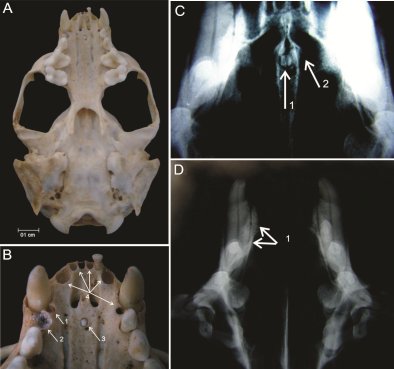IUCN/SSC Otter Specialist Group Bulletin

|
©IUCN/SCC Otter Specialist Group Volume 30 Issue 1 (January 2013) Citation: Peters, F.B., Coelho, E. de L., Vasconcelos, B.C. do E., Roth, P.R. de O. and Christoff, A.U. (2013). Dental Anomalies in Lontra Longicaudis (Carnivora: Mustelidae) collected in Southern Brazil IUCN Otter Spec. Group Bull. 30 (1): 31 - 36 Dental Anomalies in Lontra Longicaudis (Carnivora: Mustelidae) collected in Southern Brazil Felipe Bortolotto Peters1, Eduardo De Lima Coelho1, Belmiro Cavalcanti Do Egito Vasconcelos2, Paulo Ricardo De Oliveira Roth1 and Alexandre Uarth Christoff1
1Departamento de Biologia, Museu de Ciências Naturais, Universidade Luterana do Brasil. Avenida Farroupilha, 8001, 92425-900, Canoas, Rio Grande do Sul, Brasil.. e-mail:
felipe.peters@areadevida.com.br
|





|
| (Received 20th November 2012, accepted 21st January 2013) |
| Abstract: This study describes the occurrence of dental anomalies in a specimen of Lontra longicaudis from the extreme south of Brazil. The specimen examined (MCNU-1584) underwent radiographic and macroscopic analysis of the dental number, shape and structure. Anomalies were observed in the alveoli of the right PM1 and PM2, which were obstructed by bone tissue and tooth loss was possibly due to trauma or pathogenesis. The presence of a supernumerary tooth, not erupted, inclined and incisiform, was also observed on the midline of the palate. Its position and null functionality suggest that it originated because of the hyper development of the dental lamina.. |
| Keywords: Maquiné; neotropical otter; Rio Grande do Sul; supernumerary teeth |
| Française | Español | Português |
INTRODUCTION
Interference during tooth development may lead to anomalies in number (supernumeraries, agenesis), morphology (microdontia, macrodontia, twinning, merger, dens in dente) and structure (amelogenesis imperfecta, enamel hypoplasia) that become evident at any moment during the life of an organism ( Graipel et al., 1997 ; Costa et al., 2003 ; Castilho et al., 2004 ; Fernandes et al., 2005 ; Silva et al., 2005 ; Bezerra et al., 2007 ; Miziara et al., 2008 ). These changes may result from external factors such as environmental, traumatic and nutritional causes, or may have a genetic origin ( Beaver et al., 1981 ; Ten Cate, 1994 ).
Dental anomalies are widely covered in case studies involving humans ( Costa et al., 2003 ; Castilho et al., 2004 ; Fernandes et al., 2005 ; Silva et al., 2005 ; Bezerra et al., 2007 ; Miziara et al., 2008 ). Studies related to mammals are sporadic ( Drehmer et al., 2009 ) and mainly due to agenesis which, excluding pathogenic or traumatic causes, is reflected by the absence of teeth ( Bezerra et al., 2007 ), and hyperdontia, in which permanent supernumerary teeth may or may not erupt in any part of the mouth ( Bezerra et al., 2007 ). These phenomena have been described in Didelphidae ( Takahashi, 1974 ; Moraes et al., 2001 ), Phyllostomidae ( Ramírez-Pulido and Müdespacher, 1987 ; Rui and Drehmer, 2004 ), Felidae ( Pocock, 1940 ; Graipel et al., 1997 ), Otaridae ( Drehmer and Ferigolo, 1996 ; Braunn and Ferigolo, 2004 ; Drehmer et al., 2009 ) and Mustelidae, including the subfamily Lutrinae ( Burt, 1954 ; Hauer, 2002 ; Polechla et al., 2002 ).
In this study, we report the occurrence of dental anomalies in a specimen of Lontra longicaudis found dead on 15 November 2008 in Morro Alto, Maquiné, state of Rio Grande do Sul, Brazil (29°73’/50°16’). The specimen was a male in the adult stage of development, since the cranial sutures are completely fused and dentition is definitive. The dental anomalies were noted by macroscopic examination of the skull. The occlusal radiograph was performed to complement the assessment of the anomalies. The following conventions were adopted: I (incisor), C (canines), PM (premolars) and M (molars), followed by the number indicating the position of the upper teeth.
Different degrees of bone obstruction were detected in the alveoli of the right PM1 and PM2, besides the presence of a supernumerary tooth, not erupted, located posterior to the incisor foramens in the midline of the palate ( Figure 1 ). The absence of incisors and of the left PM1 is due to loss that occurred during the cleaning procedures of the bone material deposited in the collection of mammals at the Museum of Natural Sciences of the Universidade Luterana do Brasil (MCNU-1584).
Radiographs of the occlusal surfaces of the maxilla showed that the supernumerary tooth is incisiform and is inclined relative to the position of the original series. It is also possible to note that root fragments are present within the obstructed alveoli of the right PM1 and PM2, which discards agenesis and suggests that the loss of dental crowns is the result of trauma or pathogenesis. The obstruction of the alveoli indicates an advanced stage of resorption of root residuals and consequent replacement by bone tissue.
Any tooth that surpasses the typical number of deciduous and permanent teeth is considered supernumerary ( Heluy et al., 1993 ; Abreu-Lima et al., 2002 ). This type of abnormality is usually related to genetic atavism ( Drehmer, 2006 ) or hyper-development of the dental lamina ( Shafer et al., 1987 ; Ursi et al., 1988 ; Stuani et al., 1999 ; Cal Neto et al.,2002 ; Neville and Damm, 2004 ).
Considering atavism, characters present in ancestral lineages arise at low frequencies in a population of individuals ( Drehmer, 2006 ). However, dental modifications in the Lutrinae ancestors are related to the form and function of the molar series and not to the case study presented herein. A tendency toward a cutting function is observed in the narrow molars of the more primitive forms, while derived forms, such as the genus Lontra, show a tendency toward maceration, with rounded cusps and wide post-carnassials ( Vaughan et al., 2000 ).
The supernumerary incisor results from continued proliferation of the permanent or deciduous dental lamina, which forms a third tooth germ ( Stuani et al., 199 9). It can be considered ectopic and its development in the palatine region is common ( Castilho et al., 2004 ). In this case study, the supernumerary tooth is displaced posteriorly relative to the line of the incisors, with characteristics similar to a supplemental mesioden with a short root ( Abreu-Lima et al., 2002 ; Shafer et al., 1987 ; Stuani et al., 1999 ). As observed in the specimen MCNU-1584, most mesiodens do not erupt and can be impacted in various positions ( Stuani et al., 1999 ; Lobato et al., 2002 ). The eruption of a mesioden may cause discomfort such as inflammation of the tongue and buccal mucosa, as well as pain, numbness and localized swelling ( Heluy et al., 1993 ; Abreu-Lima et al., 2002 ). If it does not erupt, it can inadvertently remain in the jaw, not causing any serious alteration to the organism ( Silva et al., 2005 ).
The study of
Hauer (2002)
showed that the occurrence of deviations in the dental pattern of Eurasian otters (Lutra lutra) is low, affecting only 10% of the individuals analyzed (n = 1037). This phenomenon is related to instabilities that occur during the ontogenetic development of individuals, which may reflect on their behavior when alive. Specifically regarding this case study, the advanced state of root absorption of the right PM1 and PM2 and the non-eruption of the mesioden did not prevent the analyzed specimen from sustaining its predatory activity, which allowed us to dismiss these anomalies as the cause of death.
Acknowledgements - We thank the Conselho Nacional de Desenvolvimento Científico e Tecnológico (CNPq) (Processes 464797/2000-4 and 471551/2010-4), Fundação de Amparo a Pesquisa do Estado do Rio Grande do Sul for the grants to undergraduate students (FAPERGS), and the Pró-Reitoria de Pesquisa e Pós-Graduação of the Universidade Luterana do Brasil for institutional support. We especially thank the reviewer for their valuable suggestions.
REFERENCES
Abreu-Lima, F., Metisuki, C., Bordin, M.M. (2002). Mesiodens: Detecção e Intervenção Cirúrgica Precoce. Rev. Odontop. 50 (2): 69-73.
Beaver, T.D., Feldhamer, G.A., Chapman, J.A. (1981). Dental and cranial anomalies in the river otter (Carnivora: Mustelidae). Brimleyana. 7: 101-109.
Bezerra, P.K.M., Bezerra, P.M., Cavalcanti, A.L. (2007). Dentes supranumerários: revisão da literatura e relato de caso. Rev. Ciên. Méd. Biol. 6 (3): 349-356.
Braunn, P.R., Ferigolo, J. (2004). Osteopatologias e alterações dentárias em Otaria byronia (Pinnipedia, Otariidae) da costa do Rio Grande do Sul, Brasil. Iheringia Sér. Zool. 94 (2): 117-122.
Burt, W.H. (1954). Extra premolars in the river otter.J. Mammal. 35 (1): 125-126.
Cal Neto, J.O.A.P., Cunha, D.L., Miguel, J.A.M. (2002). Diastemas interincisais superiores associados a dentes supranumerários – considerações clínicas e relato de um caso. Jorn. Bras. Ortod. Ortop. Fac. 7 (39): 239-244.
Castilho, A.R.F., Pazin, D.C., Hussne, R., Carrara, C.F.C. (2004). Dente intranasal em portador de fissura de lábio e palato: relato de caso. Rev. Dental Press de Ortod. Ortop. Fac. 9 (6): 29-32.
Costa, S.J.M., Nunes, E.L., Facco, E.S. (2003). Distomolares. Rev. Fac. Odontol. Lins
15: 33-36.
Drehmer, C.J., Ferigolo, J. (1996). Anomalias e patologias dentárias em Arctocephalus G. Saint-Hilaire & Cuvier (Pinnipedia, Otariidae) da costa do Rio Grande do Sul, Brasil. Rev. Bras. Zool.
13 (4): 857-865.
Drehmer, C.J. (2006). Uma revisão dos atavismos em vertebrados. Neotrop. Biol. Conserv.1 (2): 72-83.
Drehmer, C.J., Dornelles, J.E. F., Loch, C. (2009). Variações na fórmula dentária de Otaria byronia Blainville (Pinnipedia, Otariidae) no Pacífico: registro de um novo tipo de anomalia. Neotrop. Biol. Conserv. 4 (1): 28-35.
Fernandes, A.V., Rocha, N.S., Almeida, R.A.C., Silva, E.D.O.E., Vasconcelos, B.C. (2005). Quarto molar incluso: Relato de caso. Rev. Cirur. Traum. Buco-Maxilo-Facial
5 (2): 61-66.
Graipel M.E., Cherem, J.J., Tames, D.R. (1997). Anomalia dentária em Puma concolor (Linnaeus, 1771) (Mammalia-Felidae). Est. Biol. 43: 21-24.
Hauer, S. (2002). Population analysis of dental anomalies of otters Lutra lutra from eastern Germany.
Acta Theriol.
47: 339-362.
Heluy, D., Portella, W., Gleiser, R. (1993).
Supranumerário (mesiodente) e sua influência no diastema mediano superior: Relato de um caso na F.O. UFRJ. Rev. Odontop. 2 (3): 165-170.
Lobato, A.M.R, Columbano, J.N., Souza, M.M.G. (2002). Hiperdontia na região de incisivos superiores. Jorn. Bras. Ortod. Ortop. Fac.
7 (41): 389-396.
Miziara, R.C., Mendes-Junior, C.T., Wiezel, C.E.V., Simões, A.L., Scuoteguazza, J.A.C. (2008). Um estudo estatístico da associação de sete anomalias dentais em uma população brasileira. Ciên. Cult. 3 (2): 19-28.
Moraes, D.A., Lemos, B., Cerqueira, R. (2001). Supernumerary molars in neotropical opossums (Didelphimorphia, Didelphidae). Mammal. Biol. 66: 193-203.
Neville, B.W., Damm, D.D. (2004). Patologia oral e maxilofacial. Guanabara Koogan, Rio de Janeiro.
Pocock, R.I. (1940). Description of a new race of puma (Puma concolor), with a note on an abnormal tooth in the genus. The Ann. Mag. Nat. Hist.11 (6): 307-313.
Polechla, P.J., Rodgers, T., Meinecke, T.R. (2002). Cranial and dental anomalies in the North American river otter: a comparison of a northern and southern population. IUCN Otter Spec. Group Bull. 19A: 267-270.
Ramírez-Pulido, J., Müdespacher, C. (1987). Formulas dentarias anormales en algunos murcielagos mexicanos. Acta Zool. Mex. 23: 1-54.
Rui, A.M., Drehmer, C.J. (2004). Anomalias e variações na fórmula dentária em morcegos do gênero Artibeus Leach (Chiroptera, Phyllostomidae) Rev. Bras. Zool.
21 (3): 639–648.
Shafer, W.G., Hine, M.K., Levy, B.M. (1987).
Tratado de patologia bucal. Guanabara Koogan, Rio de Janeiro.
Silva, E.R., Pereira, M., Faggioni-Junior, G.G. (2005). Anomalias dentarias – Agenesia e supranumerários – Revisão bibliográfica. Biosc. J. 21(2): 105-113.
Stuani, A.S., Stuani, M.M.B., Matsumoto, M.A.N. (1999). As complicações do diagnóstico tardio do mesiodens: Revista de literatura e relato de caso clínico. Rev. Fac. Odont. UFB.
19: 61-67.
Takahashi, F. (1974). Ocorrência de polidontia em Didelphis L. 1758 e sua possível correlação a uma forma ancestral. An. Acad. Bras. Ciênc. 46: 283-285.
Ten Cate, A.R. (1994). Oral Histology. Mosby-Year Book Inc., Saint Louis.
Ursi, W.J.S., Almeida, R.R., Almeida, J.V. (1988). Mesiodens, macrodontia e má-oclusão: Relato de caso clínico. Rev. Odont. USP. 2: 109-114.
Vaughan, T.A., Ryan, J.M., Czaplewski, N.J. (2000). Mammalogy. Saunders College Publishing, Philadelphia.
Résumé : Anomalies Dentaires d’Une Loutre Lontra Longicaudis (Carnivora: Mustelidae) decouverte dans le Sud du Brésil
Cette étude décrit les anomalies dentaires présentes sur un spécimen de Lontra longicaudis découverte à l'extrême sud du Brésil. Le cadavre examiné (MCNU-1584) a été soumis à une analyse radiographique et macroscopique des dents, de leurs formes et de leurs structures. Les anomalies ont été observées dans les alvéoles des PM1 et PM2 de droite, qui ont été obstruées par du tissu osseux. La perte de dents quant à elle était peut-être due à un traumatisme ou une pathologie. La présence d'une dent surnuméraire, non éclatée, inclinée et incisiforme, a également été observée sur la ligne médiane du palais. Sa position et son absence de fonctionnalité suggèrent que son origine serait due à l’hyper-développement de la lame dentaire.
Revenez au dessus
Resumen: Anomalías Dentarias en Lontra Longicaudis (Carnivora: Mustelidae) colectadas en el Sur de Brasil
Este estudio describe la ocurrencia de anomalías dentarias en un especimen de Lontra longicaudis del extremo sur de Brasil. Al especimen examinado (MCNU-1584) se le practicaron análisis radiográficos y macroscópicos del número, forma y estructura dentaria. Se observaron anomalías en los alveolos de PM1 y PM2 derechos, que estaban obstruidos por tejido óseo, y la pérdida del diente posiblemente se debió a trauma o patogénesis. También se observó la presencia de un diente supernumerario, no erupcionado, inclinado e incisiforme, en la línea media del paladar. Su posición y nula funcionalidad sugieren que se originó en un hiper-desarrollo de la lámina dental.
Vuelva a la tapa
Resumo: Anomalias Dentárias em Lontra Longicaudis (Carnivora: Mustelidae) coletada no Extremo Sul do Brasil
Este trabalho descreve a ocorrência de anomalias dentárias em um espécime de Lontra longicaudis proveniente do extremo sul do Brasil. O espécime examinado (MCNU-1584) passou por análise macroscópica e radiográfica do número, forma e estrutura dental. Foi observada anomalia nos alvéolos do PM1 e PM2 direito, os quais apresentavam obstrução por tecido ósseo, sendo a perda dentária proveniente possivelmente de trauma ou patogenia. Também foi verificada a presença de um dente supranumerário, não erupcionado, inclinado e incisiforme na linha média do palato, cuja posição e funcionalidade nula remetam a origem ao hiperdesenvolvimento da lâmina dentária.
Voltar ao Topo
